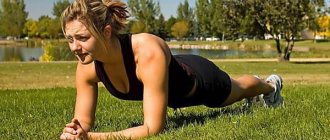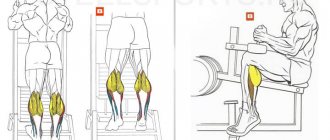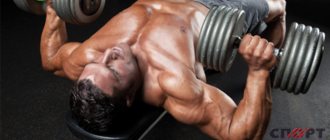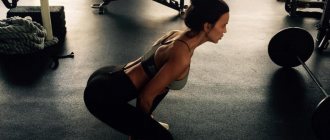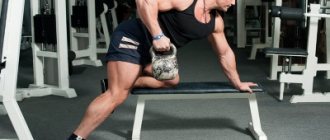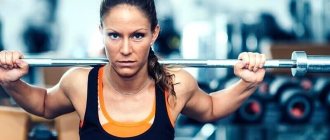A bicycle is a useful thing in all respects. This is not only a vehicle, but also a powerful simulator, which also moves in space. Calm cycling, riding with moderate or increased load, sprinting strengthen the overall protective properties of the body, increase physical endurance, normalize the functioning of the cardiovascular system, and develop major muscle groups. That is why cycling training is gaining more and more popularity every year in many parts of our planet.
Indeed, cycling loads have a number of undeniable advantages over other sports:
- an hour of cycling burns up to 400 kcal - this is the most energy-consuming type of aerobic exercise, which helps you lose extra pounds in a short time;
- cycling training allows both beginner athletes and professionals to independently regulate physical activity by simply switching the speed of the bike;
- during cycling, the main muscles of the legs and body (quadriceps of the thighs, calf, gluteal muscles, abdominal muscles, back, arms and shoulders) develop and strengthen;
- cardio training is carried out simultaneously with muscular loads: the heart rate is regulated and normalized, the condition of blood vessels improves;
- in the fresh air the lungs are ventilated, the body is freed from toxins;
- with moderate loads, the nervous system comes into balance, efficiency, learning, and concentration increase, headaches and insomnia disappear;
- the body receives large quantities of vitamin D, necessary for the skin and the whole body, which we are deprived of in closed spaces.
Finally, cycling training, due to its variety, is easier to endure mentally than any other. Indeed, we diversify not only muscle groups, intensity and duration of trips, but also cycling routes, our own impressions and sensations.
In order for cycling training to take place with maximum benefit, it is recommended to take into account several important parameters that will be discussed.
How? Where? On what?
Before you decide on your first cycling workout, you should think about where to ride and which bike to choose for this. For beginners, a regular city bike is suitable, but in professional cycling, road bikes have no competitors. Just keep in mind that the latter are designed for smooth asphalt roads. If you're going to be riding outside of the park, consider a "hybrid" that's suitable for rough terrain.
For intense cycling training, it is better to choose morning or evening hours to avoid overheating. With good equipment, people train successfully not only in warm weather, but even in winter. The main thing to remember is that you should not go cycling when the air temperature is below 8 degrees Celsius.
You need to stock up on a fitness tracker that will display your workout time, the number of kilometers traveled, and most importantly, your heart rate. Wear a bicycle helmet, but elbow and knee pads are optional for you, but recommended for children.
The benefits and harms of exercise, calorie consumption
Why you should pump up your muscles on an exercise bike
Having figured out which muscle groups are worked on an exercise bike, you also need to understand what general benefits such exercises can bring to the body.
- Strengthening the heart muscle, as well as blood vessels, is the greatest benefit from the equipment. By exercising regularly, you can prevent or minimize the risk of developing hypertension, heart attacks, and maintain the entire cardiovascular system in good shape.
- The respiratory system and lungs are also strengthened from such activities. With increased blood circulation and increased lung capacity, more oxygen will reach all tissues of our body, which significantly increases their quality.
- Riding an exercise bike trains blood vessels, making them more flexible, elastic, and mobile.
- Physical activity in general, including training on a simulator, eliminates the risk of physical inactivity, which is especially dangerous for residents of megacities. This unpleasant effect affects mental workers, office workers, drivers and everyone else who spends most of their lives sitting.
- Regular exercise can help calm the nervous system, put thoughts and psyche in order. Stress, irritation, depression often recedes after several hours of even inactive pedaling.
Among other things, it is believed that exercise bikes are even more beneficial for men, as they directly affect the prevention of prostatitis. Exercises on such equipment do not allow blood to stagnate in the pelvic area, so they will also be beneficial for women’s health.
Information for losing weight
The built-in computers on modern exercise bikes automatically determine how many calories you burn during exercise. Therefore, you don’t have to calculate anything, but not everything is so simple. Most of them show slightly inflated results in order to further motivate the athlete. Therefore, professionals recommend looking at the indicators and immediately subtracting about ten percent in order to get a real result. Special training programs will help you lose weight faster.
- Interval training on a stationary bike allows you to get rid of more calories. Their essence is quite simple - alternating intense loads with a uniform ride. For example, 20 seconds of maximum speed, and then 40 seconds of slow driving.
- The optimal time to train for weight loss is in the morning and on an empty stomach. Therefore, those who have such equipment at home are especially lucky. After a glass of water with lemon juice, just half an hour of active pedaling will start the body burning fat for energy, in the absence of new income.
- Drinking plenty of fluids throughout the day is the key to actively burning calories during exercise on an exercise bike.
On average, a simple beginner-intermediate workout will help you lose 500 to 700 calories per hour. Moreover, this indicator is influenced by many factors, from the athlete’s initial weight to riding speed and even the type of exercise machine.
Contraindications
- Bronchial asthma and other respiratory diseases.
- Cardiovascular failure.
- Hypertension.
- Tachycardia.
- Heart disease.
- Increased body temperature or inflammatory processes in the body.
- Diseases of the spine and pathologies of the musculoskeletal system.
How to achieve maximum results
If, after studying all the information, you decide to ride an exercise bike, for example, to lose excess weight or build muscles, increase overall endurance and resistance of the body, you should listen to a few simple tips from experienced ones.
- Diet along with exercise is very important. The issue of nutrition is especially relevant for those who want to lose weight. It must be balanced so that the body can receive all nutrients, minerals, macro- and microelements.
- Water is the basis of human life, so you need to consume it in sufficient quantities. Especially if we are talking about fairly significant physical activity. The body speeds up metabolic processes that require water.
- To make your workouts more effective, you should pay attention to your pulse and breathing. The maximum number of beats per minute should be approximately 130 to 170 per minute for an average level of training. You need to keep your breathing in such a mode that you can recite a poem calmly enough, without gasping for breath, without stopping driving.
Some people decide to buy an exercise bike or join a gym not at all in order to lose weight, but on the contrary, to build muscle mass. The best assistant in this matter will be not only physical activity, but also a protein diet. These are the substances the body needs to build new muscle tissue, but carbohydrate intake will have to be limited.
Alternating intensity
The alternation of work and rest has the most beneficial effect on the body. This law also applies to cycling. When drawing up a training schedule, you need to adhere to the principle of a wave-like increase and decrease in intensity. For example, if on Monday you spend 60 minutes of intense driving behind the wheel, on Tuesday it would be better to devote the same 60 minutes to a relaxed ride that restores your anaerobic base, and on Wednesday you need to rest completely or do strength training. On Thursday, you can take up intense riding with renewed vigor, increasing its duration to 80 minutes. On Friday, it would be a good idea to slightly reduce the load by choosing a moderate, even speed for skating, but let the workout increase to 90 minutes. On Saturday it is again advisable to take a break, and on Sunday go on a long three-hour trip to train your endurance (the intensity should be medium or low).
Professional athletes can travel from 500 to 800 km per week. For amateurs who want good results, 250-300 km is enough.
How should you exercise to increase the volume of your limbs?
To give you something to start with, we will provide you with a sample training program below. Now let's look at the basic rules that should be followed in order to make progress in pumping your legs on an exercise bike.
5 main rules
- Protein nutrition
- workouts for muscle development will need to be intense and difficult, if you are working on an exercise bike with cardio, then you need to shift your nutrition towards carbohydrates, which provide energy and allow you to overcome long-term workouts with endurance, if you are working on developing strength and increasing muscles, then shift your diet towards proteins, for example, simply add chicken breasts, turkey and legumes to your diet (especially on training days). - an important component. - Schedule
- heavy workouts require normal rest in order to restore muscles; at the initial stage, three hard workouts per week may be enough for you. A detailed table will help you in this matter. - Warm-up and cool-down
- the training program proposed below lasts about 40 minutes and this duration is quite enough for muscle development, but it is best to add 10 minutes at the beginning and at the end of the workout for stretching the leg muscles, a small massage and similar manipulations that increase tissue trophism and improve recovery processes. - Training tempo
- try not to slow down during the training process and not give excessive rest periods; in order for the muscles to develop, you will need to create a certain stress; otherwise, you will simply increase functionality a little, but you will not get anything special beyond the existing parameters. Pay attention to . - Leg position
- when there are no problems with the joints and you are doing a small number of repetitions at a high load, it becomes possible to slightly vary the technique and thus change the load, move your hips a little to the sides, slightly bring your toes together - with these techniques you can slightly vary the distribution of the load and give additional work for different muscles. This technique is used in
Training program
| Duration of the stage | Description |
| 5 minutes | |
| 5 minutes | |
| Minute | |
| Minute | |
| Two minutes | |
| Three minutes | |
| Minute | |
| Minute | |
| Three minutes | |
| Two minutes | |
| Two minutes | |
| Minute | |
| Two minutes | |
| 5 minutes | Increasing the load every minute by one point, up to the eighth degree. |
| Minute | High tempo, maximum work, grade 8 load. |
| 5 minutes | Reduce the load by one point every minute, with a gradual decrease in speed. |
This program uses a conditional trainer with eight levels of load. Adapt the program in proportion to the number of degrees of load on your machine.
Endurance development
Among cyclists who are preparing for long multi-day competitions, it is well known that training should begin with endurance riding. Every week you need to gradually increase the time you spend in the saddle. To stay in good shape, it is better to choose a moderate pace of movement. While cycling, you should be able to carry on a casual conversation. If you can't do this, you should choose a different rhythm that matches your heart rate.
Calf exercises in the gym
If you regularly visit the gym, do not forget to include exercises for the calf muscles in your training routine. You can do this by using the listed types of exercises, but training on exercise machines will be more effective, since pumping up a man’s calves can only be done with heavy weights.
A leg press machine is perfect for training your calf muscles
Calves can be pumped up in two ways:
- do a bench press by bending and unbending your knees and squeezing the platform with your toes;
- Straighten your legs and press the platform with your toes using your ankles, without bending your knees.
To effectively work the soleus muscles , raise your toes while sitting in a calf machine,
lowering the lever in a soft finish to his knees.
Standing calf trainer
lower the lever rollers onto your shoulders, bend and unbend your legs at the ankles.
With a large weight, it will be safe to raise on your toes in a Smith machine
.
Doing exercises
What muscles are used on a bicycle?
To increase the effectiveness of training, it is recommended to perform exercises that develop different muscle groups and help alternate loads. For example, you can choose the following action plan:
- ascent and descent of hills for 5 minutes 8 times (after a ten-minute warm-up, an ascent is performed for 5 minutes, then a descent replaces rest);
- intervals on a flat surface for 5 minutes, 5 times (at the limit of ability up to 90% of the maximum heart rate after warming up, the cyclist works for about 5 minutes, then takes a break of 1.5 minutes, after which he repeats the cycle up to 5 times);
- threshold ride for 60 minutes (after a leisurely ten-minute warm-up, the cyclist increases the pace to 75% of the maximum heart rate and remains in this state for 40 minutes. During such a ride, you should be able to say no more than 5 words in one breath, but with great effort ).
As a relaxing exercise, it is recommended to drive for a few more minutes at a calm pace. The last two complexes can be done on a home bicycle or turbo trainer.
Training program for pumping up legs on an exercise bike
The program consists of 2 stages: the preparatory part and the classes themselves.
- The preparatory part is needed to draw up a lesson plan taking into account the load on the heart. When selecting exercises, heart rate (HR) is calculated using the formula:
220 - age.Obtain the values of the maximum heart rate during physical activity per minute.
This figure is multiplied by 2 coefficients - 0.6 and 0.8.
This is the interval within which you need to keep your heart rate during training.
At the initial level, the heart rate is kept at 60% of the maximum.
The average level allows for an increase in heart rate of up to 70%.
Trained athletes increase the value to 80% of the permissible value.
- Training program:
- 5 min – free pace with a load of 4-5 units;
- 5 min – average pace at 6;
- 1 minute of medium pace and 1 minute of fast pace at resistance 8;
- 60 seconds break.
Do 3-4 approaches under pulse control. Load 8 at the initial level of training is included from 2–3 weeks of training.
From 2 months, a minute break is replaced by a smooth decrease in load - 1 minute each - 7, 6, 5, 4.
Then the cycle is repeated.
There is another training option:
- 5 minutes at an easy pace with a heart rate of 60% of maximum;
- 5 minutes at an average pace with a heart rate of 70%;
- with good physical fitness, add 5 minutes with a heart rate of 80%.
The load on the simulator is average - 2–4. These exercises are suitable for weight loss. In combination with a diet, weight loss of up to 7 kg is guaranteed in 2-3 months.
Proper nutrition
A cyclist's diet directly depends on the intensity of the workout. If you are going to train at low to moderate intensity, your normal daily diet will be sufficient; no additional refueling will be required before leaving the house. But if you have to drive a long distance, you need to take care of additional sources of energy.
To do this, during the day before training, you need to eat fist-sized portions of food, so as not to create excessive stress on the digestive system, and two hours before leaving the house, avoid food altogether. During long rides, it is useful to alternate foods rich in glycogen with foods rich in quickly digestible carbohydrates. These snacks should be done every 45 minutes. For example, you can eat a gelatin candy, and next time - a handful of nuts or a previously stored candy bar. In this case, you need to pay attention to the calorie content of “sports” bars and drinks, and if necessary, divide them into portions. To maintain hydration, you can add half a spoon of table salt to smoothies or plain water. Do not drink a lot to wet your throat, two or three sips will be enough.
After training, you are allowed to drink up to a liter of water, and a few hours later eat a full, healthy lunch.
How to work your calf muscles?
It is very difficult to answer this question, since the calf muscles practically do not increase here. They become more prominent, and sometimes even decrease in volume. Therefore, here we can only talk about pumping up the calves and making this muscle group more developed.
As you know, calves are generally difficult to train and require a significant number of repetitions. To increase volume, you will objectively need to use weight work and specific exercises like the Arnold donkey.
Even if you work with a heavy load on an exercise bike, your calves do not receive a separate and specific load, although they work quite actively.
Long and frequent workouts will give you more sinewy calves, and you will be able to gain elastic and functional muscles. Pumping for volume will require a combination of some isolated calf movements in combination with an exercise bike.
A good option for additional training is to place your feet on your toes or on the edges of the pedals.
We strongly discourage you from using this technique regularly, but in order to give an accentuated load to your calves, you can do 20-30 movements at maximum load.
The most comprehensive overview of everything related to training on an exercise bike is
Also watch the video:
We hope this information helped you learn how to make your legs more prominent using this exercise machine.
Exercise bike training
should be interval, that is, high speed and high resistance for a short period of time. Why is that? Let's look at runners as an example. Those runners who do a 5-10 km race have dry and unattractive muscles, and all because slow muscle fibers are developing. But short-distance runners have the largest and most toned muscles. This is because during short runs, fast muscle fibers develop, which are responsible for speed, strength and muscle size.
The training promises to be hellish; beginners should not even think about it. Its duration is 24 minutes.
The load is set for the simulator, which has a maximum level of 25.
Recovery
Recuperation is no less important than the period of intense energy expenditure. Muscle overstrain can unsettle you for a long time and drive away any desire to train. That is why it is advisable to create a cycling training schedule in advance, taking into account all other life stresses, as well as your health status.
Once cycling and exercise become a habit, you can increase the intensity. Regardless of what prompted you to start cycling, the desire to lose weight or the natural desire for a healthy lifestyle, do not forget about the delights of the process itself: the joy of overcoming, the delight of the opportunities that open up, the beauty of the result!
Train smart and always have fun!
How to effectively pump up your calves at home?
Let’s look at a few “at-home” exercises that won’t require anything other than enthusiasm. In essence, this is an instruction on how to pump up a girl’s calves.
"On your toes"
: walk, run, jump rope, walk or run up the stairs on your toes, and bend your knees normally when walking, running and jumping.
"Climber":
stand in a plank position, alternately bring your legs to your stomach, springing from the floor, and lowering them, bend your ankles as much as possible. This exercise will not only pump up your calf muscles, but also strengthen your abs, upper back and shoulder girdle.
"Springs":
standing on the floor, rise on your toes to the maximum possible amplitude and lower without touching your heels to the floor.
By doing this, you will pump up the soleus muscles more effectively, but for the desired result, you need to put a load on your knees.
If you are doing this exercise on a step, stand on the edge and go up and down as much as you can until you feel a stretch in your calf muscles.
You can “spring” without your heels touching the floor,
and in a deep half-squat, legs spread wide. At the same time, tighten your buttocks and outline your thigh muscles.
“Jumping” from a
plie
will also help effectively pump up the dorsal surface of the lower leg: jump as high as possible from the squat position. Weighten the exercise with a weight. But it is not advisable to do this exercise with a child because of the danger of missing it.
Make a half bridge:
lying down, resting only the back of your head, shoulder blades and feet on the floor (legs bent at the knee joints, pelvis raised), fully extend your ankles. Make the exercise heavier by placing a weight on the pelvic area below the abdomen. Do the exercise first on one leg, then on the other. Along the way, you will train your buttocks.
Physiological adaptations
Basic training is performed at an aerobic pace. The body receives enough oxygen for the intensity at which you ride.
In turn, the production of lactic acid is controlled. Contrary to popular belief, lactic acid is not something that causes muscles to burn during an intense workout. Lactic acid is actually a fuel created by a chemical reaction in muscles that burn oxygen to produce energy.
Inside muscle cells are mitochondria - these are the so-called power plants of your body. It is in the mitochondria that lactic acid is burned and energy is produced. When the mitochondria in muscle reach their limit in processing lactic acid, the remaining lactic acid enters the bloodstream.
With proper basic training, the level of lactic acid in the blood does not increase. This means that the mitochondria in the muscles are able to process all the lactic acid produced and do not need to release it into the bloodstream. By riding at a baseline intensity, you train your mitochondria to process lactic acid and stimulate them to become more efficient at burning fat for fuel.
If you train too intensely, you teach your mitochondria to burn more glycogen than fat.
So how long should an effective core workout last?
Basic training doesn't have to be long
Many people think that basic training is at least four hours of boring riding, but this is not entirely true. Yes, professionals ride for 5-6 hours and spend up to 30 hours a week in the saddle.
But for those of us who aren't aiming for the Tour de France, it's worth focusing on the quality of the training rather than the length of the training.
Consistency of effort and riding time in the correct zone is the key to success. For example, a two-hour ride with a cadence of 90-100 rpm and 60-70% of the maximum heart rate is better than a three-hour ride with a lot of effort on the climbs and descents with zero effort.
For those who don't have a lot of time to train, you can ride in the upper limit of the base zone (65-70% of maximum heart rate / 65-75% of FTP). But remember, if it becomes harder to breathe, it means you are going too fast.
During basic training, it is good to practice technique.
How long do you need to pedal to lose weight (table)
Below is a table that you can use as a guide when training. However, these numbers should not be considered absolute: for the most part, they are just a guideline that you can take into account when creating a training schedule and determining the duration of each workout. In addition, you can use the energy consumption table.
Generally speaking, you need to exercise for about 40 minutes: it is this kind of training that allows you to deplete glycogen reserves and start the process of processing adipose tissue. Thanks to this, you will be able to burn calories in a targeted manner and turn on the metabolic process during the non-training period.
| Duration of training | Travel speed | Calories burned |
| 20 minutes | 15-20 km/h | 150 |
| 40 minutes | 15-20 km/h | 300 |
| hour | 15-20 km/h | 450 |
| 20 minutes | 20-30 km/h | 200 |
| 40 minutes | 20-30 km/h | 400 |
| hour | 20-30 km/h | 600 |
| 20 minutes | 30-35 km/h | 250 |
| 40 minutes | 30-35 km/h | 500 |
| hour | 30-35 km/h | 700-800 |
Calorie expenditure varies depending on the level of training of the body: at the initial stage (the first six months of training), your body will spend more calories, since the load will be specific to the body. Further, after the physical condition of the body improves, calorie expenditure will decrease, and the body will spend energy more carefully and rationally. This will make it more difficult for you to achieve the desired level of calorie burning, but your overall metabolism will be better.
Attention! Losing weight is a complex process, and calories in this matter are only a guideline that helps you follow a specific exercise schedule and track your own achievements. However, you shouldn’t expect to lose weight right away.
Once you have burned a certain amount of calories, fatty tissue disappears gradually throughout the body. To evaluate the result, focus on reducing body volume.
The number of calories burned is greatly influenced by speed. As a rule, the higher the speed, the more calories are burned, but it is not always the fat tissue that is processed. Therefore, speed is not the highest priority in this case. We'll talk about this briefly below.
Body position also has a certain impact. These figures are indicated for the vertical version of the standard type simulator.
